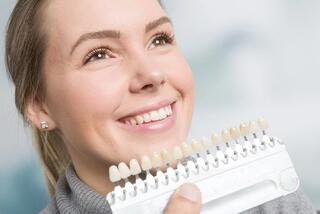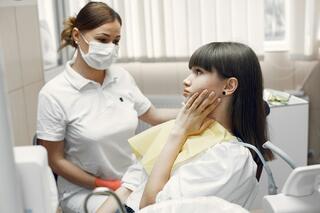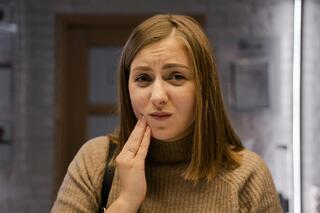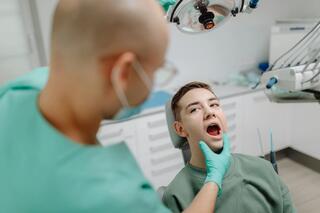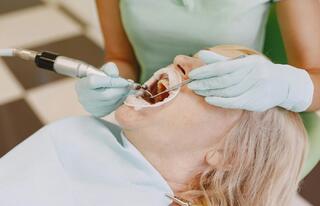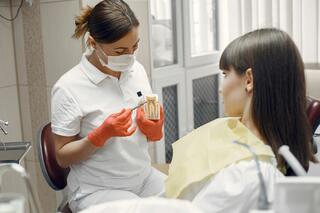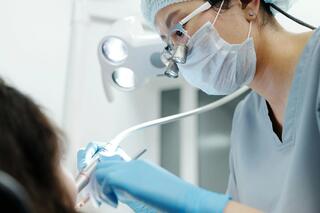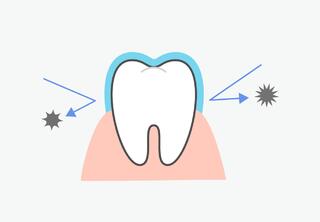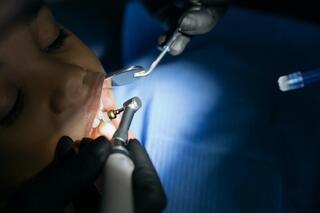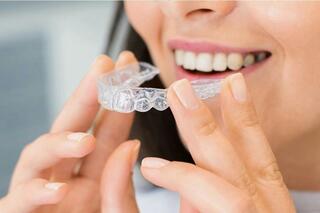Why is it important to start treating bruxism early?
Constant teeth grinding arises from muscle spasms. Overstrain in the joint can lead to tissue injury.
Initially, the pathology causes discomfort and disrupts the function of the jaw joint. The jaw constantly clenches, leading to muscle hypertonus (overstrain). Teeth grinding results in enamel wear, chip formation, sensitivity, and can harm fixed dental restorations or implants. It causes temporomandibular joint disorder (TMJ), neck stiffness, and headaches. With TMJ, ear and facial pain occur. The jaw may grind or crunch upon opening.
For bruxism, neuromuscular treatment is recommended. Doctors note that headaches and tension gradually decrease from the early stages of treatment.
Types of Bruxism
By manifestation characteristics
- Loud. Characterized by a squealing sound when clenching the jaw, leading to rapid tooth wear and oral injuries.
- Quiet. Identified by less obvious grinding sounds during tooth friction, causing minor injuries like tooth surface cracks.
- Mixed. Combines symptoms of both the above types.
By time of occurrence
- Daytime. The patient clenches teeth during stress or intense mental activity.
- Nighttime. The patient grinds teeth at night, without conscious control.
- Time-independent.
Who Should You Consult?
Bruxism is dangerous not only because it causes tooth damage, but it can also lead to temporomandibular joint disorders (TMJD). Constant damage to the oral mucosa paves the way for chronic inflammation. Therefore, it's crucial to visit a doctor at the first signs of the condition.
The first point of contact should be a general dentist. If they suspect the development of an anomaly, they will refer the patient to a gnathologist, a dental orthopedist specializing in joint issues.
Given the complexity of the problem, diagnosing and treating bruxism in adults often involves a neurologist, general practitioner, otolaryngologist, and psychiatrist.
Causes of Bruxism
The exact causes of bruxism are not definitively known. The condition often arises from factors such as:
- Dental diseases. Uncontrolled teeth grinding is commonly due to malfunctions in the dental-jaw apparatus (like improper bite, issues with the temporomandibular joint, etc.).
- Treatment errors. Grinding can occur due to the placement of unsuitable fillings, orthodontic devices, or fixed dental restorations.
- Nervous system malfunctions. Adult bruxism can develop against the backdrop of epilepsy, dementia, tremors, Parkinson's disease, and somnambulism (sleepwalking).
- Sleep physiology characteristics. Involuntary activation of the brain cortex during night sleep can stimulate muscle activity aimed at closing the lower jaw.
- ENT pathologies. Factors like difficulty in nasal breathing due to a deviated septum, chronic rhinitis, or allergies can stimulate bruxism.
There are many theories about the development of adult bruxism. The exact cause can only be determined after a detailed medical examination.
Symptoms of Bruxism
- Uncontrolled teeth grinding;
- Wedge-shaped defects;
- High sensitivity of the enamel layer;
- Surface layer cracks;
- Chips, fractures of crowns;
- Gum recession;
- Headaches (often after waking up);
- Dizziness;
- Jaw pain;
- Ear discomfort;
- Nighttime sleep issues, daytime sleepiness;
- Spasm of masticatory muscles;
- Neck pain in the spinal area.
Neuromuscular Diagnosis
Neuromuscular diagnosis aims to thoroughly study the anatomy of the masticatory apparatus and determine the optimal position of the jaws and teeth. Special equipment is used in the process, including:
Myomonitor. A device that evaluates the dental-jaw apparatus through electromyostimulation. It's also used therapeutically to relieve hypertonus in the masticatory muscles.
Electromyograph. Designed to determine the structure of local muscles, assess the ergonomics of the temporomandibular joint, and identify dental bite pathologies.
Sonograph. Helps detect the slightest noises in the TMJ, indicating the development of certain pathologies.
AxioGraph. An instrument for extraoral diagnostics that records the movements of the lower jaw at rest, during chewing, and swallowing.
Treatment of Bruxism
The treatment methods for adult bruxism depend on the causes of its onset. If the development of bruxism is due to dental issues, occlusal therapy is immediately implemented:
Orthodontic treatment: Correcting pathological dental bites using braces or aligners.
Orthopedic treatment: Restoring the integrity of the dental row through tooth restoration, adjusting unsuitable fixed dental restorations.
Therapeutic treatment: Restoring function and integrity of teeth in cases of enamel cracking and the appearance of wedge-shaped defects due to bruxism.
Pharmacological therapy: Prescribing muscle relaxants, anti-inflammatory drugs, and botulinum toxin injections into the facial muscles involved in chewing.
Dentists unanimously recommend wearing removable protective mouthguards for bruxism. These are custom-made in laboratories from polymers based on individual impressions. Patients wear them on their teeth at night. The device prevents full closure of the teeth, protecting the enamel layer from premature wear.
Daytime teeth clicking is treated with self-control. Sometimes, daytime protective mouthguards are used. They are convenient to use: almost invisible on the teeth, do not distort speech, and do not cause pain or discomfort during chewing.
Complications
Without timely treatment, the disease can cause serious complications:
- Loosening and fracture of teeth;
- Pathological wear of enamel;
- Multiple caries;
- Gum inflammation;
- Bite disorders;
- TMJ diseases.
A patient with bruxism strongly clenches their jaws — their head tilts downward, leading to a shift in the central axis and posture disruption. Nighttime bruxism can lead to the development of sleep apnea. The consequences of the pathology hinder proper tooth restoration.
Prognosis and Prevention
The prognosis for treating the disease is favorable. Early detection of the pathology can prevent serious complications.
For prevention, dentists advise:
- Regular dental check-ups (once every six months);
- Providing adequate load to the jaw muscles by eating hard foods (raw vegetables and fruits);
- Normalizing emotional well-being and self-control.
Frequently Asked Questions
What does "securing the result" mean in the treatment of nighttime teeth grinding?
If the treatment course includes wearing a brace system (bite correction), immediately after its removal, the patient must wear a retainer — a device that prevents the teeth from returning to an incorrect position. The duration of wearing the retainer is determined individually by the doctor.
How long does bruxism treatment take?
The duration of therapy is determined by the specifics of the clinical case. Treatment can be lengthy. The specialist can only provide an estimate of the therapy duration after the initial diagnosis.
Is it painful to wear a brace system?
Pain may concern the patient during the adaptation period and after replacing the orthodontic arch. Usually, the discomfort subsides within 5-7 days. In patients with a low pain threshold, pain may persist for 4-6 weeks.

